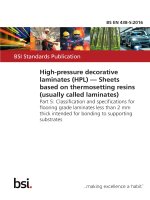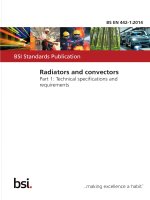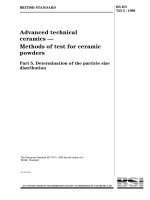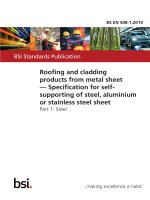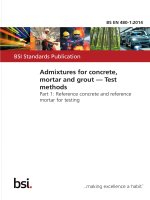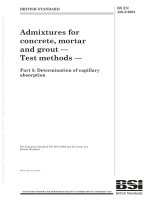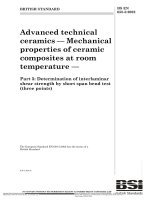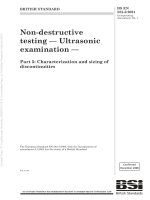Bsi bs en 12007 5 2014
Bạn đang xem bản rút gọn của tài liệu. Xem và tải ngay bản đầy đủ của tài liệu tại đây (1.24 MB, 30 trang )
BS EN 12007-5:2014
BSI Standards Publication
Gas infrastructure — Pipelines
for maximum operating
pressure up to and including 16
bar
Part 5: Service lines — Specific functional
requirements
BS EN 12007-5:2014
BRITISH STANDARD
National foreword
This British Standard is the UK implementation of EN 12007-5:2014.
The UK committee generally supports the content of this EN standard
and the safety principles it represents. The Introduction acknowledges
that it is not a Design Handbook nor a Code of Practice and that
additional national and company standards describing the details are
needed. Under UK gas safety legislation, gas companies are required
to comply fully with UK Gas Safety Regulations as part of their License
to Operate. The companies are also obliged to complete a Safety Case
document, which includes: technologies employed, standards, codes
and competencies of personnel etc., and have it approved by the UK
Health and Safety Executive as part of their operating licence, which is
issued by the Office of Gas and Electricity Markets, OFGEM. Another
essential requirement of the operating license is ensuring economic
costs of gas transportation and distribution.
Consequently, UK gas infrastructure operating companies might make
certain departures from the specific detailed requirements mentioned in
Part 5 in order to comply simultaneously with the safety and economic
criteria.
The UK participation in its preparation was entrusted to Technical
Committee GSE/33, Gas supply.
A list of organizations represented on this committee can be obtained
on request to its secretary.
This publication does not purport to include all the necessary provisions
of a contract. Users are responsible for its correct application.
© The British Standards Institution 2014.
Published by BSI Standards Limited 2014
ISBN 978 0 580 78071 4
ICS 23.040.01
Compliance with a British Standard cannot confer immunity from
legal obligations.
This British Standard was published under the authority of the Standards
Policy and Strategy Committee on 31 July 2014.
Amendments/corrigenda issued since publication
Date
Text affected
BS EN 12007-5:2014
EN 12007-5
EUROPEAN STANDARD
NORME EUROPÉENNE
EUROPÄISCHE NORM
April 2014
ICS 23.040.01
English Version
Gas infrastructure - Pipelines for maximum operating pressure
up to and including 16 bar - Part 5: Service lines - Specific
functional requirements
Infrastructures gazières - Canalisations pour pression
maximale de service inférieure ou égale à 16 bar - Partie 5:
Branchements - Recommandations fonctionnelles
spécifiques
Gasinfrastruktur - Rohrleitungen mit einem maximal
zulässigen Betriebsdruck bis einschließlich 16 bar - Teil 5:
Hausanschlussleitungen - Spezifische funktionale
Anforderungen
This European Standard was approved by CEN on 8 February 2014.
CEN members are bound to comply with the CEN/CENELEC Internal Regulations which stipulate the conditions for giving this European
Standard the status of a national standard without any alteration. Up-to-date lists and bibliographical references concerning such national
standards may be obtained on application to the CEN-CENELEC Management Centre or to any CEN member.
This European Standard exists in three official versions (English, French, German). A version in any other language made by translation
under the responsibility of a CEN member into its own language and notified to the CEN-CENELEC Management Centre has the same
status as the official versions.
CEN members are the national standards bodies of Austria, Belgium, Bulgaria, Croatia, Cyprus, Czech Republic, Denmark, Estonia,
Finland, Former Yugoslav Republic of Macedonia, France, Germany, Greece, Hungary, Iceland, Ireland, Italy, Latvia, Lithuania,
Luxembourg, Malta, Netherlands, Norway, Poland, Portugal, Romania, Slovakia, Slovenia, Spain, Sweden, Switzerland, Turkey and United
Kingdom.
EUROPEAN COMMITTEE FOR STANDARDIZATION
COMITÉ EUROPÉEN DE NORMALISATION
EUROPÄISCHES KOMITEE FÜR NORMUNG
CEN-CENELEC Management Centre: Avenue Marnix 17, B-1000 Brussels
© 2014 CEN
All rights of exploitation in any form and by any means reserved
worldwide for CEN national Members.
Ref. No. EN 12007-5:2014 E
BS EN 12007-5:2014
EN 12007-5:2014 (E)
Contents
Page
Introduction .........................................................................................................................................................5
1
Scope ......................................................................................................................................................6
2
Normative references ............................................................................................................................7
3
3.1
3.2
Terms and definitions ...........................................................................................................................8
General terminology ..............................................................................................................................8
Pressure related terminology ............................................................................................................ 10
4
4.1
4.2
4.3
4.3.1
4.3.2
4.3.3
4.3.4
4.3.5
4.4
4.4.1
4.4.2
4.4.3
4.5
4.6
Design .................................................................................................................................................. 10
General ................................................................................................................................................. 10
Protection ............................................................................................................................................ 11
Materials and components ................................................................................................................ 12
General ................................................................................................................................................. 12
Isolation valve ..................................................................................................................................... 12
Flow limiting device ............................................................................................................................ 13
Venting devices................................................................................................................................... 13
Regulators and meters ....................................................................................................................... 13
Service line routing............................................................................................................................. 13
External routing .................................................................................................................................. 13
Wall and floor transition ..................................................................................................................... 13
Internal routing.................................................................................................................................... 14
Pipe sizing ........................................................................................................................................... 15
Identification ........................................................................................................................................ 15
5
5.1
5.2
5.3
5.4
Construction ........................................................................................................................................ 15
General ................................................................................................................................................. 15
Storage, handling and transportation............................................................................................... 16
Service line installation ...................................................................................................................... 16
Connections to existing gas infrastructure ..................................................................................... 17
6
6.1
6.2
6.3
6.3.1
6.3.2
6.4
Quality control..................................................................................................................................... 17
Quality management system ............................................................................................................. 17
Inspection prior to installation .......................................................................................................... 17
Inspection during installation ............................................................................................................ 17
Ground conditions .............................................................................................................................. 17
Joint integrity ...................................................................................................................................... 18
Competence ........................................................................................................................................ 18
7
7.1
7.2
7.3
7.4
7.5
7.6
7.7
7.8
Pressure testing .................................................................................................................................. 18
General ................................................................................................................................................. 18
Safety during pressure testing .......................................................................................................... 19
Prior to testing .................................................................................................................................... 19
Test mediums ...................................................................................................................................... 19
Measurement equipment ................................................................................................................... 19
Strength test ........................................................................................................................................ 19
Tightness test...................................................................................................................................... 20
Failed pressure test ............................................................................................................................ 20
8
8.1
8.2
Commissioning and decommissioning ............................................................................................ 21
General ................................................................................................................................................. 21
Purging ................................................................................................................................................ 21
9
9.1
Operation and maintenance .............................................................................................................. 21
General ................................................................................................................................................. 21
2
BS EN 12007-5:2014
EN 12007-5:2014 (E)
9.2
Record system and traceability ......................................................................................................... 22
Annex A (normative) Jointing methods ........................................................................................................... 23
A.1
General ................................................................................................................................................. 23
A.2
Threaded joints .................................................................................................................................... 23
A.3
Fusion, welded, brazed and soldered joints ..................................................................................... 23
A.4
Mechanical joints ................................................................................................................................. 23
A.5
Pressed joints ...................................................................................................................................... 23
A.5.1 General ................................................................................................................................................. 23
A.5.2 Pressed joints for copper pipe ........................................................................................................... 24
Bibliography ...................................................................................................................................................... 25
3
BS EN 12007-5:2014
EN 12007-5:2014 (E)
Foreword
This document (EN 12007-5:2014) has been prepared by Technical Committee CEN/TC 234 “Gas
infrastructure”, the secretariat of which is held by DIN.
This European Standard shall be given the status of a national standard, either by publication of an identical
text or by endorsement, at the latest by October 2014 and conflicting national standards shall be withdrawn at
the latest by October 2014.
Attention is drawn to the possibility that some of the elements of this document may be the subject of patent
rights. CEN [and/or CENELEC] shall not be held responsible for identifying any or all such patent rights.
This document has been prepared under a mandate given to CEN by the European Commission and the
European Free Trade Association, and supports essential requirements of EU Directive(s).
This European Standard is part of the series EN 12007 "Gas infrastructure — Pipelines for maximum
operating pressure up to and including 16 bar" which comprises the following parts:
—
Part 1
General functional requirements;
—
Part 2
Specific functional requirements for polyethylene (MOP up to and including 10 bar);
—
Part 3
Specific functional requirements for steel;
—
Part 4
Specific functional requirements for renovation;
—
Part 5
Specific functional recommendations of new service lines.
According to the CEN-CENELEC Internal Regulations, the national standards organizations of the following
countries are bound to implement this European Standard: Austria, Belgium, Bulgaria, Croatia, Cyprus, Czech
Republic, Denmark, Estonia, Finland, Former Yugoslav Republic of Macedonia, France, Germany, Greece,
Hungary, Iceland, Ireland, Italy, Latvia, Lithuania, Luxembourg, Malta, Netherlands, Norway, Poland, Portugal,
Romania, Slovakia, Slovenia, Spain, Sweden, Switzerland, Turkey and the United Kingdom.
4
BS EN 12007-5:2014
EN 12007-5:2014 (E)
Introduction
This European Standard describes the general functional requirements for gas supply through service line
pipe systems and covers the pressure range up to and including 16 bar maximum operating pressure (MOP).
It gives normative and informative references for safe and secure gas infrastructures. It applies to their design,
construction, operation and the related aspects of safety, environment and public health, all in order to provide
a safe and secure supply of gas.
This European Standard is intended to be used in addition to the EN 12007 series of European Standards.
The requirements of this European Standard are based on safe gas engineering practice under conditions
normally encountered in the gas industry. Requirements for all unusual conditions cannot be specifically
provided for, nor are all engineering and construction details prescribed.
Existing industrial safety regulations applying to work areas, safety devices and safe work practices are not
intended to be supplanted by this European Standard.
Persons responsible for the design, construction and operation of gas infrastructures should have regard to
the guidance given in this European Standard, the EN 12007 series of European Standards and to other
relevant standards. It is the responsibility of these persons to apply these functional requirements,
supplemented with other proven good practice to the particular circumstances of each gas infrastructure.
The recommendations in this European Standard are intended to be applied by competent persons who have
suitable knowledge and experience. Notes in the text are informative.
The designer, constructor or operator of service line and pipeline systems is cautioned that this European
Standard is not a design handbook or code of practice. Additional national or company standards describing
the details are needed. These detailed standards should be in line with the basic principles of this European
Standard.
All pressures are gauge pressure unless stated otherwise.
In preparing this European Standard it was recognised that the suite of relevant European Standards is
incomplete. Reference may be made where appropriate to international, national or other standards until
relevant European Standards are available.
5
BS EN 12007-5:2014
EN 12007-5:2014 (E)
1
Scope
This European Standard describes the specific functional requirements for service lines in addition to the
general functional requirements of EN 12007-1 for:
a)
a maximum operating pressure (MOP) up to and including 16 bar;
b)
an operating temperature between -20 °C and +40 °C.
It applies to their design, construction, commissioning, decommissioning, operation, maintenance, extension
and other associated works. The service line is the physical asset comprising of pipework from the gas main
branch saddle or top tee to the outlet of the distribution system operator’s nominated point(s) of delivery (for
example: isolation valve, regulator, meter connection or combination of regulator and isolation valve).
The ownership and operation responsibility can vary between member states. The extent of the service line
can differ in each member state. To illustrate this, the various points of deliveries are indicated in Figure 1.
Consult Figure 1 (A/B/C/D/E) and member state regulations and standards.
NOTE
The valve at point A is not necessarily utilised by each member state.
National preference for points of deliveries should be stated in the national foreword.
Key
P
gas main
Distribution system operator nominated Point(s) of Delivery:
T
Top Tee / Branch Saddle
A
outlet of below ground service line valve outside the building
M/R
Meter and/or Regulator
B
outlet of above ground service line valve outside the building
C
outlet of meter/regulator outside the building
D
outlet of above ground service line valve inside the building
E
outlet of meter/regulator inside the building
Figure 1 — Distribution system operator nominated point of delivery
Specific functional requirements for:
—
polyethylene pipelines are given in EN 12007-2.
—
steel pipelines are given in EN 12007-3.
—
pipework for buildings are given in EN 1775.
6
BS EN 12007-5:2014
EN 12007-5:2014 (E)
—
pressure regulating installations are given in EN 12279 or EN 12186.
—
pressure testing, commissioning and decommissioning are given in EN 12327.
This European Standard represents the recommendations at the time of its preparation. It does not apply
retrospectively to installations before the publication date unless specifically stated.
This European Standard specifies common basic principles for gas infrastructure. Users of this European
Standard should be aware that more detailed national standards and/or code of practice may exist in the CEN
member countries. This European Standard is intended to be applied in association with these national
standards and/or codes of practice setting out the above-mentioned basic principles.
In the event of conflicts in terms of more restrictive requirements in national legislation/regulation with the
requirements of this European Standard, the national legislation/regulation takes precedence as illustrated in
CEN/TR 13737 (all parts).
CEN/TR 13737 (all parts) gives:
—
clarification of all legislations/regulations applicable in a member state;
—
if appropriate, more restrictive national requirements;
—
a national contact point for the latest information.
2
Normative references
The following documents, in whole or in part, are normatively referenced in this document and are
indispensable for its application. For dated references, only the edition cited applies. For undated references,
the latest edition of the referenced document (including any amendments) applies.
EN 751-1, Sealing materials for metallic threaded joints in contact with 1st, 2nd and 3rd family gases and hot
water - Part 1: Anaerobic jointing compounds
EN 751-2, Sealing materials for metallic threaded joints in contact with 1st, 2nd and 3rd family gases and hot
water - Part 2: Non-hardening jointing compounds
EN 751-3, Sealing materials for metallic threaded joints in contact with 1st, 2nd and 3rd family gases and hot
water - Part 3: Unsintered PTFE tapes.
EN 1057, Copper and copper alloys - Seamless, round copper tubes for water and gas in sanitary and heating
applications
EN 1254 (all parts), Copper and copper alloys — Plumbing fittings
EN 1775:2007, Gas supply - Gas pipework for buildings - Maximum operating pressure less than or equal to 5
bar - Functional recommendations
EN 1776, Gas supply systems - Natural gas measuring stations - Functional requirements
EN 10226-1, Pipe threads where pressure tight joints are made on the threads - Part 1: Taper external
threads and parallel internal threads - Dimensions, tolerances and designation
EN 10226-2, Pipe threads where pressure tight joints are made on the threads - Part 2: Taper external
threads and taper internal threads - Dimensions, tolerances and designation
EN 10241, Steel threaded pipe fittings
7
BS EN 12007-5:2014
EN 12007-5:2014 (E)
EN 10242, Threaded pipe fitting in malleable cast iron
EN 12007-1:2012, Gas infrastructure - Pipelines for maximum operating pressure up to and including 16 bar Part 1: General functional requirements
EN 12007-2:2012, Gas infrastructure - Pipelines for maximum operating pressure up to and including 16 bar Part 2: Specific functional requirements for polyethylene (MOP up to and including 10 bar)
EN 12007-3, Gas infrastructure - Pipelines for maximum operating pressure up to and including 16 bar - Part
3: Specific functional recommendations for steel
EN 12186, Gas supply systems - Gas pressure regulating stations for transmission and distribution Functional requirements
EN 12279, Gas supply systems - Gas pressure regulating installations on service lines - Functional
requirements
EN 12327, Gas infrastructure - Pressure testing, commissioning and decommissioning procedures Functional requirements
3
Terms and definitions
3.1 General terminology
For the purposes of this document, the following terms and definitions apply.
3.1.1
gas infrastructure
pipeline systems including pipework and their associated stations or plants for the transmission and
distribution of gas
3.1.2
gas main
pipework in a gas infrastructure to which service lines are connected
3.1.3
service line
pipework from the gas main to the point of delivery of the gas into the installation pipework
3.1.4
casing
protection by means of a construction around the pipeline in order to prevent external loads, or third party
interference
3.1.5
sleeve
protective pipe through which a gas pipe passes
3.1.6
point of delivery
point of a gas network where the gas is transferred to the user
Note 1 to entry:
connection.
This can be at a means of isolation (e.g. at the outlet of a LPG storage vessel) or at a meter
Note 2 to entry:
For this European Standard, the point of delivery is typically nominated by the distribution system
operator and can be defined in National Regulations or Codes of Practice, see Figure 1.
8
BS EN 12007-5:2014
EN 12007-5:2014 (E)
3.1.7
authorised person
competent person who is appointed to fulfil a given task on gas infrastructure
3.1.8
competent person
person who is trained, experienced and approved to perform activities relating to gas infrastructures or
installation pipework
Note 1 to entry:
Means of approval, if any, will be determined within each member country.
3.1.9
flow limiting device
purpose manufactured self-actuating device which can limit or stop uncontrolled excess flow of gas
3.1.10
installation pipework
pipework downstream of the point of delivery terminating at the appliance inlet connection
Note 1 to entry:
This pipework is normally the property of the customer.
3.1.11
purging
process for safely removing air or inert gas from pipework and/or pipeline components and replacing it with
gas, or the reverse process
Note 1 to entry:
A distinction is made between the following methods:
— direct purging is the displacement of air by gas or vice versa;
— indirect purging is the displacement of air by inert gas followed by the displacement by gas or vice versa.
Note 2 to entry:
versa.
Alternatively by means of a barrier (a slug of inert gas or a pig) between the air and the gas or vice
3.1.12
pipeline components
elements from which the pipeline is constructed
Note 1 to entry:
The following are distinct pipeline elements:
— pipes, including cold formed bends;
— fittings;
— ancillaries;
— pressure vessels.
EXAMPLE 1
Reducers, tees, factory-made elbows and bends, flanges, caps, welding stubs, mechanical joints.
EXAMPLE 2
Valves, expansion joints, insulating joints, pressure regulators, pumps, compressors.
3.1.13
strength test
specific procedure to verify that the pipework and/or station meets the requirements for mechanical strength
9
BS EN 12007-5:2014
EN 12007-5:2014 (E)
3.1.14
tightness test
specific procedure to verify that the pipework and/or station meets the requirements for tightness
3.1.15
combined test
specific procedure to verify that the pipework and/or station meets the requirements for mechanical strength
and tightness
3.2 Pressure related terminology
3.2.1
design pressure
DP
pressure on which design calculations are based
3.2.2
maximum operating pressure
MOP
maximum pressure at which a system can be operated continuously under normal operating conditions
Note 1 to entry:
Normal operating conditions are described as no fault in any device or stream.
3.2.3
strength test pressure
STP
pressure applied to a system during strength testing
3.2.4
tightness test pressure
TTP
pressure applied to a system during tightness testing
3.2.5
combined test pressure
CTP
pressure applied to a system during combined testing
4
Design
4.1 General
4.1.1
Any person who is responsible for the design of service lines shall be a competent person.
4.1.2 Gas infrastructures shall be designed to provide a safe and continuous supply of gas. This design
considers technical aspects and procedures together with environmental and safety aspects in accordance
with Clause 7 of EN 12007-1:2012.
4.1.3 The characteristics of materials of pipes, fittings and components and the mode of construction of
service lines shall be appropriate to the types of gas being supplied and the conditions under which they are
operated.
4.1.4 The design of the service line under normal operational conditions shall address, at a minimum but
not be limited to, the effects of:
—
10
the MOP and flow rates;
BS EN 12007-5:2014
EN 12007-5:2014 (E)
—
ground subsidence;
—
temperature, and fluctuations (high or low);
—
loading due to depth of cover;
—
chemical corrosion by water, e.g. extra-ordinary acids, salts and (cyclic) hydrocarbons;
—
other underground infrastructures (operating under normal conditions);
—
mechanical impact e.g. manual digging tools, vehicles, etc.;
—
gas velocity causing erosion;
—
seismic activity; and
—
UV exposure.
NOTE
Additional considerations from external elements can also include:
— traffic loading;
— stray electrical currents; and
— gradual growth of tree roots.
4.1.5
The design should consider additional measures based on the following factors:
—
location of service line e.g. outside/inside, above ground/below ground, etc;
—
the building usage;
—
the supply pressure;
—
the local public and traffic density; and
—
the response time to make safe.
4.1.6 Service lines shall be designed and constructed to facilitate maintenance. The distance to other
structures and infrastructures should be considered.
4.1.7 For emergency isolation, maintenance and alteration there shall be a minimum of one manual
isolation valve. The manual isolation valve shall be accessible to the distribution system operator and/or the
consumer.
4.1.8 Specific additional protection measures should be considered to minimise any impact of failure of
service line components where practicable.
4.1.9
Connections to the gas main shall not weaken or compromise the gas system.
4.2 Protection
4.2.1
The design shall consider protection of the service line from impact, corrosion, UV and vandalism.
4.2.2 The design shall protect against the uncontrolled release of gas, or the serious aggravation of fire and
minimise the likelihood of an explosion. This can be achieved by the use of one or more of the following
provisions:
11
BS EN 12007-5:2014
EN 12007-5:2014 (E)
—
automatic means of isolation or flow limiting device;
—
manual means of isolation;
—
routing all or part of the service line in an area of minimum consequence;
—
location of all or part of the pipework in a suitable sleeve, or casing;
—
use of materials, components and joints that withstand high temperatures;
—
coating pipework with a protective material to enable the pipework to withstand high temperatures for a
given period of time.
Reference should be made to the national legislation/regulation.
NOTE
For pipework internal to the premises Annex A of EN 1775:2007 gives, as examples, two procedures (A & B)
for tests on components of pipework and their jointing for resistance to high temperatures.
4.2.3 Where an electrical cable, water main or other services can potentially damage the gas service line
additional protection of the service line should be considered.
Where proximities required by national requirements cannot be achieved, consideration can be given to other
mitigating measures.
4.2.4 Metallic service lines shall be fitted with a suitable electrical insulating joint located to fulfil this
function.
4.3 Materials and components
4.3.1
General
4.3.1.1
Materials and products shall conform to the relevant European Standards and International
Standards or, in their absence, to the national or other established standards and shall be of a quality fit for
purpose.
PE materials and components used shall comply with EN 12007-2.
Steel pipes shall comply with EN 12007-3.
Copper tube shall comply with EN 1057 and copper or copper alloy fittings shall comply with EN 1254 (all
parts).
4.3.1.2
Characteristics such as chemical and mechanical properties or dimensions of final product or
manufacturing or test procedures shall be subject to agreement between distribution system / service line
operator and manufacturer subject to compliance with the relevant standard(s).
4.3.1.3
The material characteristics of pipeline components and the mode of construction of pipelines
shall be appropriate to the family of gas being transported and the conditions under which they are operated.
4.3.1.4
Jointing methods shall comply with the requirements of Annex A.
4.3.1.5
The choice of material should be considered as a solution to increased protection and the
reduction of sound, vibration and erosion.
12
BS EN 12007-5:2014
EN 12007-5:2014 (E)
4.3.2
Isolation valve
A minimum of one isolation valve shall be installed (see 4.1.7) to facilitate emergencies, alterations and
maintenance.
4.3.3
Flow limiting device
Consideration should be given to the operating pressure and/or flow rate when selecting a flow limiting device.
4.3.4
Venting devices
4.3.4.1
Where the service line incorporates a device that vents gas, the location of the outlet vent shall
ensure that gas is vented to outside and shall not lead to a dangerous situation. Measures shall be taken to
ensure that vented gas is not permitted to come into contact with spark ignition sources or is not be permitted
to enter the building, e.g. via air conditioning intake systems.
4.3.4.2
Where a vent pipe is fitted, it shall be dimensioned so not to impair safe operation.
4.3.4.3
The termination of vent pipes shall be protected against the ingress of foreign substances, such
as dust, water, soil and snow.
4.3.4.4
4.3.5
The requirements of EN 12279 or EN 12186 shall apply for pressure regulating devices.
Regulators and meters
Where the regulator and meter form part of the service line the requirements of 4.1, 4.2, 4.3.1 and 4.3.4.4
shall apply in addition to 5.6 of EN 1775:2007. For non-domestic installations the requirements of EN 1776
shall apply.
4.4 Service line routing
4.4.1
External routing
4.4.1.1
The service line shall be routed as near perpendicular as practicable from the building it supplies
to the gas main, and shall be located to minimise the risk of damage caused by the influences in 4.1.4.
4.4.1.2
Service lines shall be routed in straight lines where possible and take the shortest route from the
gas main to the building. Service lines should be routed where it is expected to remain accessible to the
network operator.
4.4.1.3
Where service lines are routed under parts of buildings or through cavities they shall be placed in
a continuous sleeve ensuring that in the event of a leak in the service line, any escaping gas is diverted to a
safe or detectable location.
4.4.1.4
Service lines shall be routed so as to avoid existing storage material areas and existing trees.
4.4.1.5
A minimum of 300 mm depth of ground cover shall apply, but may be increased based on
national standards/regulations.
Additional protection against damage shall be provided where services are being laid at less than 300 mm of
cover.
4.4.1.6
The use of an identification system is recommended where possible e.g. marker tape.
13
BS EN 12007-5:2014
EN 12007-5:2014 (E)
4.4.2
Wall and floor transition
4.4.2.1
Gas pipework including any sleeves shall not impair the building’s construction requirements, e.g.
mechanical stability, fire resistance, thermal and sound insulation.
4.4.2.2
Sleeves shall be sealed to the structure of the building.
4.4.2.3
Pipes shall not be installed within wall cavities. Pipes passing through cavities in walls and floors
shall be located within a sleeve.
The annulus between the pipe and sleeve shall be sealed.
NOTE
For an example of how to achieve such a seal see Figure 2.
Where the pipe enters the building, the non-setting sealant between pipe and sleeve shall not cover the joint
between bend and pipe.
EXAMPLE
Figure 2 h, g
Key
a
outside wall
f
sleeve
b
cavity
g
elbow or bend
c
insulation
h
non-setting sealant between pipe and sleeve
d
inside wall
i
grout
e
pipe clip
Figure 2 — Example of suitable sleeve arrangement
4.4.2.4
Pipes passing through floors or walls shall do so by the shortest route.
4.4.2.5
Sleeves shall be of a material which is resistant to corrosion and is impermeable to gas.
14
BS EN 12007-5:2014
EN 12007-5:2014 (E)
4.4.3
Internal routing
4.4.3.1
The route of the service line shall be as short as practicable and the number of joints kept to a
minimum. The use of diagonal routes should be avoided.
4.4.3.2
Service lines should be located in accessible and ventilated spaces. Where it is not possible to
achieve adequate ventilation, other solutions shall be applied, e.g.:
—
ventilated sleeves or ducts,
—
pipes which are all welded, all brazed or joint-free, or
—
the filling of the space around the pipe with inert materials, etc.
All ventilated sleeves and ducts shall be ventilated to a safe location.
4.4.3.3
Where service line pipework is concealed, particular attention shall be given to the mode of
construction and corrosion protection of the service line.
4.4.3.4
The position of the service line in relation to other services shall be such that it can function
properly and be used safely.
4.4.3.5
Service lines shall not be located near to high voltage conductors or hot or chilled water systems
nor subjected to vibrations unless appropriate precautions are taken.
Spaces reserved for other uses, such as lift shafts, garbage chutes, ventilation or air conditioning systems,
electrical transformers and sewage pipes should be avoided unless specific precautions are taken.
4.5 Pipe sizing
4.5.1 Service lines shall be sized so that the pressure at the point of delivery is at minimum equal to the
contracted delivery pressure.
Account should be taken of the maximum flow rate together with any foreseeable increase in the load.
NOTE
The maximum flow rate for sizing the pipework is not necessarily equal to the total gas flows to all appliances.
The minimum pressure in the gas main should also be taken into consideration.
The characteristic of the distributed gas should be taken into consideration.
4.5.2 In instances of a number of premises being supplied from a single service line, the service line should
be designed to take simultaneous usage into consideration.
4.5.3 Consideration shall be given to the change in pressure due to the height of the building, in particular
for pipework operating at pressures less than 100 mbar.
4.5.4
Pipe sizing should be considered as a solution to reducing sound, vibration and erosion.
4.6 Identification
Where a service line can be confused with other pipework it shall be identified in accordance with a
recognised national standard or equivalent.
NOTE 1
This can be achieved by marker tape, colour identification, banding etc.
NOTE 2
The colour yellow typically identifies gas pipework.
15
BS EN 12007-5:2014
EN 12007-5:2014 (E)
5
Construction
5.1 General
5.1.1 The safety of personnel engaged on gas service lines and of members of the public shall be ensured
throughout the period of works. Considerations shall be given to the needs of the elderly or disabled.
5.1.2 Service lines shall be laid only by competent persons using the appropriate equipment necessary to
complete the work in conformance with the relevant standards.
5.1.3
Jointing methods shall comply with the requirements of Annex A.
5.2 Storage, handling and transportation
After transport, storage and handling and before assembly on site, the condition of pipes, their coatings, and
fittings shall be checked. Before assembly and laying, all pipes and fittings shall also be checked for
obstructions or blockages.
NOTE 1
Specific requirements for the storage, handling and transportation of PE pipe are included in EN 12007-2.
NOTE 2
Specific requirements for the storage, handling and transportation of steel pipe are included in EN 12007-3.
5.3 Service line installation
5.3.1 Before constructing the service line, materials, tooling, equipment and equipment settings shall be
inspected for suitability for the construction process in accordance with the material manufactures' instructions
and specifications.
5.3.2 During the construction of pipework care shall be taken to prevent the ingress of foreign matter (e.g.
dirt, water, flux, swarf, thread cutting oil) into the pipework. Foreign matter which has entered the pipework
shall be removed.
NOTE
Thread cutting oil can affect thread sealants.
5.3.3 Localised factors that were not considered during the design process shall be taken into account.
These factors can include, but are not limited to, the following:
—
possibility of third party interference;
—
nature of soil;
—
location of other buried services and obstacles;
—
traffic loadings;
—
laying techniques.
5.3.4
Where the soil conditions surrounding the service line are unsuitable:
—
the soil quality should be improved;
—
material selection should be revised; and/or
—
the service line should be re-routed.
5.3.5 Where it is not possible to maintain the normally accepted burial depth of cover in accordance with
4.4.1.6, additional protective measures of the service line shall be provided.
16
BS EN 12007-5:2014
EN 12007-5:2014 (E)
5.3.6 Where required proximities from other utilities, cannot be achieved other mitigating measures such as
protective material shall be placed between the utilities, see 4.2.3.
5.3.7 The trench bottom shall be free of any sharp objects liable to damage the pipe or its external coating.
The pipe shall be protected by suitable means, such as stone dust, sand or mechanical protection.
5.3.8 During laying and before backfilling, the pipework and any protective coatings shall be checked for
defects and repaired as necessary.
EXAMPLE
Local deformations, worn spots, cuts and scratches.
5.4 Connections to existing gas infrastructure
5.4.1 Checks should be carried out to identify the correct infrastructure to which the connection is intended
to be made.
5.4.2 The connection of service lines to existing gas infrastructures shall be planned and built in a manner
that ensures the safety and continuity of gas supply and the safe carrying out of the intended work. This shall
include measures to minimise the escape of gas, provide suitable safety equipment for personnel and
measures for minimising the risk of ignition and the control of fires should they occur.
5.4.3 The design and construction of the connection shall consider any special requirements of the existing
pipe materials. Specific material requirements for service lines are given in EN 12007-2 and EN 12007-3.
EXAMPLE 1
Ensuring no discharge of static electricity from polyethylene pipes.
EXAMPLE 2
Ensuring electrical continuity when steel pipes are jointed or separated.
EXAMPLE 3
Ensuring electrical insulation between steel pipes and cast iron pipes.
5.4.4 The service line shall be installed so that it does not impose excessive stresses on connecting
components and vice-versa.
NOTE
6
This can be achieved by the addition of supporting brackets or joints which provide flexibility.
Quality control
6.1 Quality management system
6.1.1
For quality management systems see EN 12007-1.
6.1.2
The quality management system should include, for each activity:
—
adequate numbers of competent persons;
—
adequate other resources.
EXAMPLE
Vehicles, communication systems and appropriate tools.
6.1.3 Equipment shall be periodically calibrated as specified by the manufacturers' instructions or the
distribution system operator.
6.2 Inspection prior to installation
Pipes, fittings and associated equipment shall be inspected prior to installation to confirm the quality and
suitability for installation in accordance with the relevant European Standards, International Standard and
national standards.
17
BS EN 12007-5:2014
EN 12007-5:2014 (E)
EXAMPLE 1
PE pipes, components and fittings meet the requirements of EN 12007-2.
EXAMPLE 2
Steel pipes, components and fittings meet the requirements of EN 12007-3.
6.3 Inspection during installation
6.3.1
Ground conditions
Soil and trench conditions shall comply with 5.3.
6.3.2
Joint integrity
6.3.2.1
Joints shall be visually inspected following procedures approved by the distribution system
operator. The inspection shall be carried out by the personnel engaged in the jointing.
EXAMPLE
For electro-fusion visual examinations of the fitting indicator is verified by the manufacture's instructions.
6.3.2.2
Any additional inspection shall be carried out by a competent person at a frequency depending on
the conditions of use. The inspection should be recorded.
NOTE
Further information regarding inspection methods is given in Annex B of EN 12007-2:2012.
6.4 Competence
The qualification of competent persons involved in the design, construction, operation and maintenance of a
gas infrastructure, or parts of it, shall be in accordance with the characteristics of the pipeline system they are
working on. These characteristics include, but are not limited to the following:
—
family of gas;
—
local conditions;
—
design or operating pressure;
—
routing;
—
materials used in the system;
—
jointing techniques; and
—
emergency procedures.
7
Pressure testing
7.1 General
7.1.1 Pressure testing procedures to prove the integrity of the service lines shall be in accordance with
EN 12327.
7.1.2 The distribution system operator shall be responsible for ensuring that the system being operated has
undergone suitable pressure testing prior to commissioning.
7.1.3 The test pressure shall not have a negative effect on connected pipework and pipework components.
Where the required test pressure is higher than the pressure rating of connected pipework and components
this pipework shall be isolated from the test pressure.
18
BS EN 12007-5:2014
EN 12007-5:2014 (E)
7.1.4 New service lines require a strength test in accordance with 7.6 and a tightness test in accordance
with 7.7.
7.1.5 Existing service lines that have been altered or are being re-commissioned shall only require a
tightness test in accordance with 7.7.
7.1.6
The service line can be tested together with the gas main or in individual sections.
7.1.7
Testing requirements have been satisfied when no leakage is found.
NOTE
This can be verified when:
— the difference between the pressure measured at the start and completion of the test falls within the acceptable
allowance as determined by national standard; and
— no leakage is found during the gas survey of all joints with an approved leak detection fluid complying with
EN 14291 or with gas detection equipment.
7.1.8 Pressure testing of service lines against closed valves is permitted. Under these circumstances the
network operator shall ensure that the valves are suitable to withstand the test pressure
7.2 Safety during pressure testing
7.2.1
Safety procedures during testing shall be in accordance with EN 12327.
7.2.2 The authorised person shall take measures to indicate that a test is in progress. Any area deemed to
be dangerous shall be identified and access prohibited as necessary.
7.2.3
When introducing pressure to the service line, the increase shall be progressive and not sudden.
7.3 Prior to testing
7.3.1 Prior to testing, the authorised person shall have full knowledge of the service line and shall verify the
validity of information about the service line. The authorised person shall ensure that the service line has been
constructed in accordance with the design specifications.
7.3.2 All service line open ends shall be closed. Any device used to seal the service line shall be capable of
withstanding the test pressure.
7.3.3 Precautions shall be taken, where necessary, to prevent the flow of air or inert gas into the gas main
upstream or the installation pipework downstream.
7.4 Test mediums
7.4.1
The test medium shall be one of the following:
—
air;
—
inert gas (e.g. nitrogen);
—
distributed gas; or
—
water.
7.4.2 When the test fluid is introduced, precautions shall be taken to ensure that the pressure inside the
service line does not exceed the specified test pressure, see Table 1 for pressure relationships.
19
BS EN 12007-5:2014
EN 12007-5:2014 (E)
7.4.3 Where the use of air, inert gas or water is not practicable, it is acceptable to use the distributed gas as
a test fluid for tightness tests carried out at operating pressure, provided that all joints are easily accessible.
7.5 Measurement equipment
The leak measurement equipment shall be sufficiently sensitive for the application.
7.6 Strength test
7.6.1
The strength test is normally applied to new service lines.
7.6.2 The strength test can be performed as a combined test with the tightness test. In this instance, the
combined test pressure (CTP) is equal to strength test pressure (STP).
Table 1 – Pressure relationships
MOP
Bar
STP/CTP
5,0 < MOP ≤ 16,0
> 1,30 MOP
2,0 < MOP ≤ 5,0
> 1,40 MOP
0,1 < MOP ≤ 2,0
> 1,75 MOP
MOP ≤ 0,1
> 2,50 MOP
(1)
(1)
Where MOP is less than the design pressure (DP), the
pressure relationships in this table can be related to DP.
7.6.3 Where the strength test is not combined with the tightness test, the strength test shall precede the
tightness test.
7.6.4 The duration of the strength test shall be to the time required to confirm, by appropriate means, that
there has been no rupture in the service line. The duration can be specified in national standards. Where the
strength test is combined with the tightness test the duration of the strength test shall be equal to that required
of the tightness test.
7.6.5 All components of the service line, which are not capable of withstanding the pressure selected for the
test shall be removed prior to the test, e.g. regulators, meters, means of isolation, safety devices.
In this case either the component shall be replaced with a section of pipework, or parts of the service line
situated upstream and downstream of the removed component shall be sealed and tested separately.
7.6.6 Pipework, not included in the pressure test, shall be disconnected or isolated before the strength test
is performed.
7.7 Tightness test
7.7.1 All service lines shall be subject to a tightness test. In some cases this is carried out in combination
with the strength test, see 7.6.2.
7.7.2
The applied tightness test pressure shall not be greater than the strength test pressure (STP).
7.7.3 The tightness test pressure shall be at least the operating pressure of the system where no previous
strength test has been carried out.
7.7.4 The duration of the tightness test shall be the time required to confirm, by appropriate means, that
there has been no leakage in the service line. The duration can be specified in national standards.
20
BS EN 12007-5:2014
EN 12007-5:2014 (E)
7.8 Failed pressure test
7.8.1 When pressure tests have failed, leaks shall be identified by appropriate means e.g. use of an
approved leak detection fluid complying with EN 14291.
Where leak detection fluid is used on components made of stainless steel, the level of chlorine in the leak
detection fluid should be below 30 mg/l.
7.8.2
8
Defective parts shall be replaced or repaired and service line retested.
Commissioning and decommissioning
8.1 General
8.1.1
The systems shall be commissioned and decommissioned in accordance with EN 12327.
8.1.2 Service lines shall only be commissioned after successful pressure testing in accordance with
Clause 7. Commissioning shall proceed immediately after successful pressure tightness testing in accordance
with 7.7.
8.2 Purging
8.2.1
Purging shall be carried out in accordance with EN 12327.
8.2.2
When introducing pressure to the service line, the increase shall be progressive and not sudden.
8.2.3
Precautions shall be taken to prevent any accidental ignition of purge gases.
8.2.4 Purging should be carried out outside by venting or flaring off the flammable purged gases. Vent
points shall be located at the end of the pipework and shall be supervised throughout the purging operation.
Purge gases may be flared off to reduce environmental emissions and unnecessary public reported gas
escapes.
A flexible purge hose terminating with a metallic end or a flame trap can be used to vent purge gases to a safe
location, preferably to outside air. The vent hose should be sufficiently supported and the direction of the wind
should be taken into account.
8.2.5
NOTE
Purging shall only be carried out inside by flaring off the flammable purged gases.
Suitable appliance burners can be used.
8.2.6 The purging process is completed when a safe and acceptable gas concentration is established at the
venting point.
8.2.7
Commissioning is completed when only distributed gas is present in the service line.
8.2.8
Decommissioning is completed when the presence of flammable gases are below a safe limit.
9
Operation and maintenance
9.1 General
9.1.1 Operation, survey and maintenance of service lines shall be in accordance with EN 12007-1:2012,
13.1, 13.3, 13.4, 13.5, 13.6, and 13.7.
21
BS EN 12007-5:2014
EN 12007-5:2014 (E)
9.1.2 The storage of materials or planting of trees above service lines is not permitted if it impairs
accessibility and safe operation of a service line.
9.1.3 To avoid spark ignition and or electrical shocks electrical continuity shall be installed before
disconnection or connection work commences on metallic service lines.
9.1.4 The distribution system operator should give operating instructions to the customer on the customer
means of isolation of the supply of gas.
9.2 Record system and traceability
9.2.1 The distribution system operator should consider establishing a record system for new service lines
and keep it up to date.
NOTE
The record system can include the following information:
— gas family;
— initial construction, testing and commissioning data;
— system for the location of the service line;
— the service line characteristics; and
— pipework components integrated into the system for operation and maintenance.
9.2.2 If the service line drawings are handed over to the person responsible for the operation of the
building, these shall be updated to reflect the as built situation.
9.2.3 Necessary instruction to locate the service line should be made available to interested utilities,
authorities or third parties.
22
BS EN 12007-5:2014
EN 12007-5:2014 (E)
Annex A
(normative)
Jointing methods
A.1 General
Jointing methods shall comply with EN 12007-2 for PE and EN 12007-3 for steel.
A.2 Threaded joints
A.2.1
NOTE 1
A.2.2
Threaded joints for pipework shall comply with EN 10226-1 or EN 10226-2.
The application of taper/taper threaded joints may be prohibited in some countries.
Threaded joints shall not be made with thread forms conforming to different standards.
A.2.3 Threaded pipe fittings shall comply with EN 10242 (malleable cast iron), or EN 10241 (steel), or
EN 1254-4 (copper and copper alloys).
A.2.4 Sealants shall comply with EN 751-1, EN 751-2 and EN 751-3. Sealants shall be used with threaded
joints and shall be applied to threaded pipe joints in accordance with the sealant manufacturer’s instructions.
Sealants shall not be used for pipework that might be subjected to lower or higher temperatures than specified
in the manufacturer’s instructions.
NOTE 2
The choice of sealant types may be limited in some countries.
A.3 Fusion, welded, brazed and soldered joints
Joints of this type shall only be performed by persons with a specific competence.
NOTE
Soldering is not permitted in some countries.
A.4 Mechanical joints
A.4.1
NOTE
Mechanical joints shall conform to the appropriate standards.
Such standards are:
— ISO 10838 for mechanical fittings for PE;
— EN 15266 for stainless steel pliable corrugated tubing fittings
— EN 1092-1, EN 1515-1 for flanges; and
— EN 1254-2 and EN 1254-3 for copper compression joints.
A.4.2
Mechanical joints used in pipework shall be resistant to pipework forces e.g. tension, bending, torsion.
23

